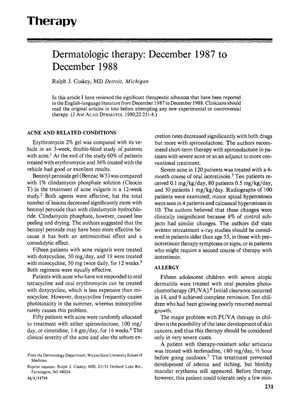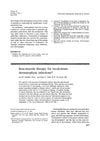Dermatologic Therapy: December 1987 to December 1988
February 1990
in “
Journal of The American Academy of Dermatology
”

TLDR New skin treatments in 1987-1988 showed effectiveness for various conditions, but some had side effects or risks.
Between December 1987 and December 1988, numerous studies reported advancements in dermatologic therapies. Erythromycin 2% gel was effective in 60% of acne patients, while benzoyl peroxide gel outperformed clindamycin phosphate in reducing acne lesions. Doxycycline and minocycline were equally effective for acne vulgaris, but doxycycline had a risk of phototoxicity. Spironolactone surpassed cimetidine in reducing acne severity. Oral isotretinoin was effective for severe acne, though it had some side effects. PUVA therapy aided severe atopic dermatitis in adolescents but had skin cancer risks. Pentoxifylline improved livedo vasculitis, and chronic ulcers were healed using cultured allogenic keratinocytes and topical prostaglandin E₂. Acitretin cleared cutaneous lupus erythematosus in most patients. Minoxidil 2% induced hair growth in one-third of male pattern hair loss patients, and thymopentin achieved complete regrowth in 35% of severe alopecia areata patients. Itraconazole was effective against dermatophyte infections, and naftifine cream treated cutaneous candidiasis and tinea infections. Intralesional sodium stibogluconate and bleomycin treated cutaneous leishmaniasis. Interferon-beta gel and acyclovir were promising for herpes treatment. UVB therapy relieved AIDS-associated eosinophilic folliculitis, and dithranol with UVB was effective for psoriasis. Anthralin combined with corticosteroids cleared psoriasis faster but increased folliculitis risk. A vitamin D3 analogue and fish oil showed potential in psoriasis treatment. The document highlights the importance of clinicians reviewing original articles before using new or controversial therapies. Fish oil improved psoriasis symptoms in a study with 28 patients, while acitretin was effective in a 24-week study and in a comparison with etretinate in 175 patients. Ketoconazole cream treated seborrheic dermatitis in 72 patients, and cryotherapy had a 97% cure rate for nonmelanoma skin cancers in 395 patients. A 10-year PUVA study with 1380 patients indicated an increased risk of squamous cell carcinoma. Various treatments for other dermatologic conditions were also discussed, with studies ranging from double-blind trials to case reports.
